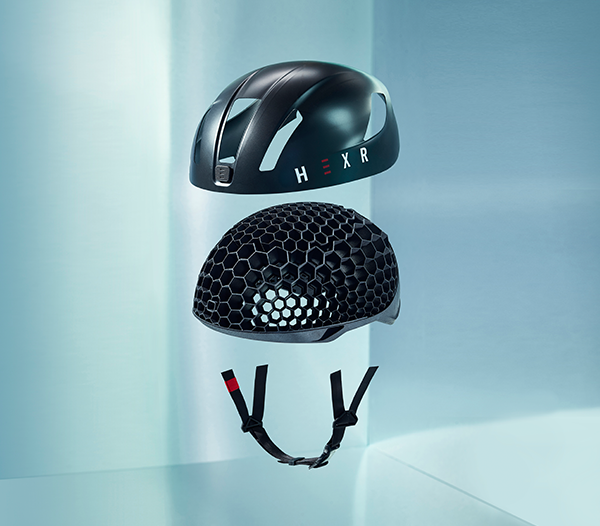Protective clothing specialist HEXR, with the help of leading PBF manufacturer EOS, has launched a new head scanning app allowing users to have a custom cycling helmet 3D printed. The “scan-to-print” platform is intended as a flexible and decentralized production system, enabling customizability without sacrificing product safety. Additional support in the development of the app came from global technology company Siemens and materials specialist Arkema.

Fitting the dome
The HEXR fitting app works like so: customers around the world scan their own heads using the camera built into their phones (this is aided by AR and a special cap sent out by HEXR). These scans are uploaded via the app and a 3D model of the inner lining of a helmet matching the head shape is printed on an industrial-grade EOS system. The material used is a plant-based polyamide produced by Arkema. Once printing is complete, the inner lining is dyed black and inspected one last time for structural integrity and finish quality.
Jamie Cook, CEO at HEXR, states: “With custom-fit intrinsic to this leading-edge manufacturing process, and superior independent safety test scores compared with traditional foam helmets, we are enabling major improvements in helmet technology made possible by 3D printing.”
To finish up, the various components of the helmet are assembled, including the printed inner structure, the outer shell, and the chinstraps. Customers also have the option to add a bit of extra spin on the product with personal engravings and a variety of shell colors. Since the helmets are printed on-demand, HEXR faces minimal risk with pre-financing and overproducing, which allows the company to just focus on refining its service.

Reinventing the sustainable supply chain
The polyamide used for the inner lining is derived entirely from renewable castor oil – an area of expertise for Arkema. The beans grow in less than a year, do not compete with other food, and do not contribute to deforestation. The material itself has excellent impact resistance and is fairly lightweight, even more so when printed in the clever honeycomb structure formulated by HEXR.
Dr. Karsten Heuser, Vice President of Additive Manufacturing at Siemens, concludes: “With the help of our end-to-end solutions, we created a digital twin of an industrialized AM factory and helped to optimize the design and streamline production processes – even before production started. By combining simulations, design optimization, and production scenarios with a high degree of automation, we were able to predict and reduce cost per part significantly – enabling HEXR to scale their application into mass production.”

HEXR’s partnership with EOS actually began in 2015 when EOS started providing support in the form of technical consulting. Last year, the duo underwent final safety testing and announced their helmets would begin shipping to customers. Since then, HEXR has managed to bring in its additional industrial partners and hopes to grow to mass production, scaling its supply chain along the way.
Just this month, EOS, along with BASF, also secured $1.37M in funding for developing 3D printed protective headgear for the ongoing NFL Helmet Challenge. Leveraging the novel approach to protective gear fabrication, the companies taking part were able to create safer products while saving on weight and costs – paving the way for a new application of the technology.
The nominations for the 2020 3D Printing Industry Awards are now open. Who do you think should make the shortlists for this year’s show? Have your say now.
Subscribe to the 3D Printing Industry newsletter for the latest news in additive manufacturing. You can also stay connected by following us on Twitter and liking us on Facebook.
Looking for a career in additive manufacturing? Visit 3D Printing Jobs for a selection of roles in the industry.
Featured image shows the 3D printed helmet assembly. Image via HEXR.



